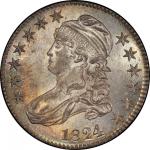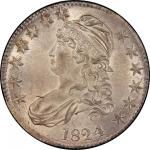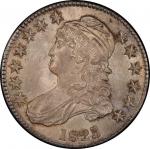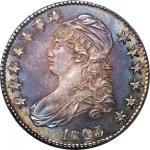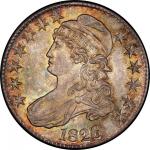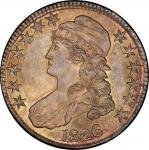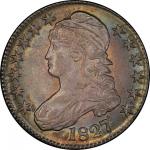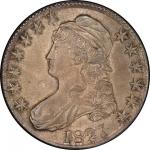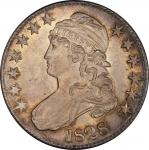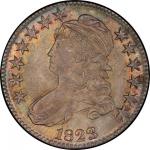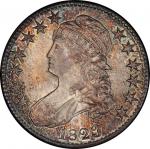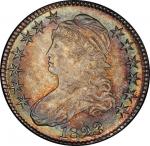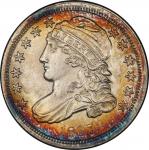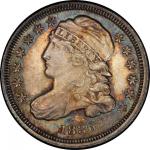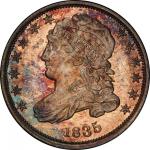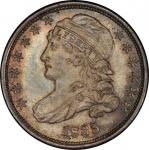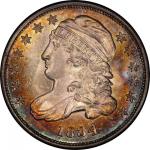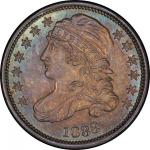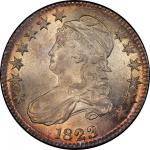“No. 1. Ugly 3; there are 3 curves in the back of the 3.” — J. Colvin Randall, John W. Haseltine’s Type-Table of United States Dollars, Half Dollars, and Quarter Dollars, 1881 Impressive cartwheel luster spins swiftly around nearly brilliant surfaces, toned with faint golden tones at the periphery that turn to rose at the rims. The frosty fields offer the ideal backdrop for the supremely detailed design elements, which are well struck on both sides and show an abundance of fine detail. Aside from some trivial hairlines, no defects are seen under magnification, and the visual appeal is immense. The portrait shows some fatigued texture, and areas near the center appear rusted; a few parallel lapping lines remain visible near Liberty’s ear, leftover from an attempt to preserve the die from damage. Two long arc cracks on the reverse frame the eagle. Both start at the rim beneath the lowest olive leaf; one goes to the left, crossing the wing and petering out in the field near the beak, while the other goes right and crosses the denomination, arrows, and wing before ending at the back of the eagle’s head. On the obverse, a short crack descends from the midpoint of the Ugly 3, intersecting the rim between two denticles. Some peripheral elements are drawn to the rim in this later die state, and stars 5 through 7 show limited central detail. J. Colvin Randall, the preeminent 19th century student of die varieties of early United States silver and gold coinage, appears to have been the first to publish this variety. Randall’s groundbreaking die variety research was published, without his full consent, as Haseltine’s Type-Table in 1881. Randall called his variety No. 1 the “ugly 3,” but its description seems to be a blend of what is today called the Ugly 3, Overton-110a, and the Patched 3, Overton-101a. His descriptions match both varieties but for the mention that “U in ‘United’ is defective at lower part” and “R in ‘America’ has only half of the stand,” which apply to Overton-101a but not Overton-110a. Beistle did not use the Ugly 3 terminology, but described each variety as distinct from the other. Overton was the first to apply the Ugly 3 nomenclature to this specific obverse, separating Randall’s Ugly 3 into two different varieties while applying the Patched 3 moniker to Overton-101a, as is used today. The best summation of the genesis of the Ugly 3 comes from Edgar E. Souders’ Bust Half Fever, which explains that “a die crack formed on the obverse ... crossed the 3, and eventually chipped out a small section of the weakened metal, thereby giving the illusion that the 3 numeral was reworked.” In other words, the central curve at the back of the 3 that was first described by J. Colvin Randall is an internal cud or die break, one whose shape and size depends upon the die state of each particular specimen from these dies. The early die state of the Overton-110 shows no break or bulge, instead, the 3 is normal in appearance. The theory that the 3 was repaired, similar to the Broken 3/Patched 3 of 1823 Overton-101 and Overton 102, seems ill-considered, based upon the observation that early die state Overton-110s show a 3 in the date that has no need for repair or any further engraving. The fourth edition of Overton includes the theory of origin espoused by Souders, corrected from earlier editions that included the repaired 3 explanation. Among varieties of 1823 half dollars recognized by PCGS and the Guide Book of United States Coins, both the 1823 Broken 3 and the 1823 Ugly 3 are actually die states rather than die varieties. The 1823 Ugly 3 represents just a fraction of the coins produced by the Overton-110 die marriage. PCGS has assigned a Mint State grade to an example of this variety on only five occasions, but they have never certified another 1823 Ugly 3 half dollar finer than MS-63. PCGS CoinFacts singles out the D. Brent Pogue specimen as “One of the nicest examples and certainly one of the most attractive” survivors of the Ugly 3, but bolder language is probably more appropriate: this is the single finest 1823 Ugly 3 half dollar known to modern numismatists. PCGS# 39623. NGC ID: 24FJ.

